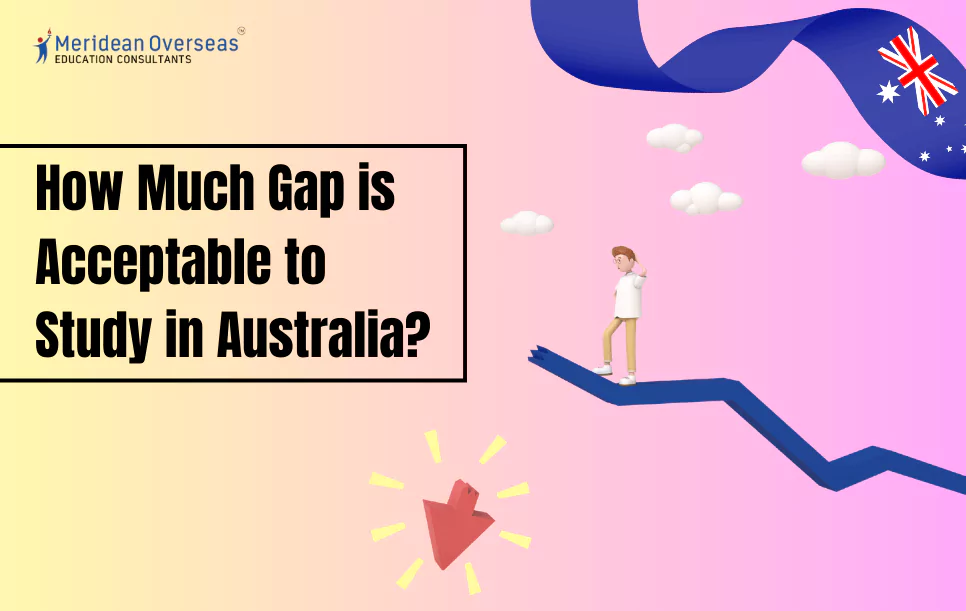
Announcements

Announcements

Meridean Overseas
Updated On 16 May 2024 & Read Time 14 minutes
8k
Welcome to Australia, a top-ranked educational destination attracting thousands of applicants to its marvellous universities. The country ranks in 2nd position in terms of the most popular places for international students to study every year.
Students choose Australia as it's a great place to study, offers fantastic chances to work, and boasts a high standard of living. Thus, such benefits make Australia an attractive location compared to other English countries. However, securing a seat at a well-renowned university in Australia demands a lot of hard work and dedication. Students tend to take a gap of months or years after finishing their school studies for varied reasons such as personal issues, monetary concerns, and pre-preparation for their degree, among others, which affects the admission process.
Regardless of the reasons, it's essential to understand the number of gap months or years that are acceptable at universities in Australia. In most universities in Australia gap acceptable period is up to 6 months without justification, but a gap longer than 6 months requires valid evidence. Moreover, factors like the type of course, undergraduate or postgraduate, also matter. Hence, justification, with proof in some cases, is necessary.
In this blog, let’s have detailed information about how many months or years of gap accepted to study in Australia.
Table of Contents
Study gaps mean a break from studies or formal education either for months or years for some particular valid reasons. For example, students who have completed undergraduate programs have a chance to complete their graduate program even after a long gap.

It is just a period when a student is busy with something else like work, travel or family obligations. Some students take this period to do something productive and explore different interests/ goals/ skills.
However, there can be some drawbacks, like, you have to explain the reasons to a new institution or employer. And the reason should be reliable. In India one year gap is usually acceptable but longer needs some strong reasons.
Need for Study Gap Justification for Australian Student Visa
A study gap justification for Australian student visa is needed because people take study gaps for various reasons, such as personal reasons, financial issues, family obligations, health issues, etc. Some may take a study break to acquire work experience and skills. Many may also discontinue formal education to understand global perspectives and career opportunities through travelling to different countries. If someone lacks financial support, they plan to work and earn enough to continue their studies again. Moreover, it is crucial to justify the gap to authorities while applying for a visa to ensure that it is accepted without a gap justification.
When you plan to study in Australia, you will find several institutions have their own set of criteria for admission. While the admission rate for a gap varies for every Australian university, there are some standard rules to follow.
All institutions usually allow a maximum of 6 months of study gap without any justification. An Australia gap acceptable period of more than 6 months would demand clarification. If you're going for bachelor's courses in Australia, then more than that 1 year is accepted on the basis of NEET or IIT exams. On the other hand, if you're going for a master's program, then a 3-4 year study gap is accepted, but you must have proper work experience and documents to justify that experience. Other pointers for student visa are determined by the types of study program, such as whether you want to register in a postgraduate or undergraduate program.
You must also express clearly why you took a gap year. In this context, those taking a gap year with the reason for the job may be called to provide their salary slips and employment documents. Conversely, those who take a year off for medical reasons must provide documentation. Thus, 6 months of a gap is generally acceptable without an excuse; otherwise, you must provide proper documentation.
Embark and excel in your study abroad journey with our expert team!

Now you know that a maximum of a 6-month gap is acceptable even without reasons, but you will need genuine evidence backed up by credible documentation. Remember that a gap of more than 6 months may create more constraints during admission to top-ranked universities in Australia. So, you must check for proper documentation for supporting reasons like health problems, personal problems, or other similar issues.
Despite having repercussions, you can engage in some productive activity relevant to your area of specialisation to secure your university seat. Doing so will give you a positive professional image and show your sincerity and seriousness to the university.
Admissions departments there consider the matter of fake or improper documents very seriously, which may lead to your permanent ban from the host country. So, as Benjamin Franklin said, “Honesty is the Best Policy,” you should adequately validate the reasons for your education gap when you assemble and present documents.
Even if it's a 1-year gap, it is acceptable; it is acceptable to universities in Australia for bachelor’s on the basis of NEET and IIT Exams preparation or score and proper documentation for the same. Yet, a lengthier interruption after your higher secondary education, like 1 year, might be detrimental to your admission chances.
Still, when you have to take a 1-year break after finishing your higher secondary education, it is highly recommended that you have a valid scorecard for the NEET or IIT Exam. If you have a 3-4 years gap after graduation, you must have a work experience certificate or a proper justification. It’s important to know that Australian universities do not accept work experience after higher education (12th class).
You should be adequately prepared with genuine shreds of evidence if you are showing personal reasons for your sabbatical, like health or financial concerns. You must understand that Australian admission offices place a high value on the accuracy of the papers you submit; it would be unwise to present improper or false information.
Now that you have justified your gap and have successfully been admitted to your desired university, head on to our next section - how to get an Australian student visa. This is where most students get stuck and can’t move forward with their higher studies in Australia.
The Overseas Program of the host country’s government offers an accessible pathway to pick your student visa for studying in Australia. Follow these steps to secure your student visa:
Apply to an Australian University: Start by applying to a university in Australia. Upon acceptance, you'll receive a Confirmation of Enrolment (CoE), a crucial document for the visa application process.
Register with Australian Immigration Authorities: Create a profile through the Australian immigration authorities' platform.
Digitise Required Documents: Ensure all necessary documents are scanned and digitised. In today's digital age, online submission is paramount.
Complete Online Visa Application: To complete your visa application online, utilise official visa application websites designed to be user-friendly and informative.
Acquire Transaction Reference Number (TRN): After submitting your application, you must pay the visa fee. Once paid, you'll receive a Transaction Reference Number (TRN).
Undergo Health Check-up: A medical check-up is required for visa approval. Arrange this well in advance and secure an interview slot with officials if necessary.
Await Visa Decision: Allow sufficient time to communicate the visa decision. Stay patient as the decision-making process unfolds.
Following the steps above, you can acquire your student visa to study in Australia through the Overseas Program.
Australian universities usually accept a 1-2 year gap in studies. However, you must present genuine reasons backed with reliable documents to justify your study gaps. Showing serious intention and willingness to further study in Australia is necessary to continue formal education there.
Students from India can apply for a student visa in Australia, known as “Student visa subclass 500.” This visa allows you to stay, study, and work in Australia for up to 5 years, aligning with your course. However, after completing your education, you can apply for a Training Visa (Subclass 407). It is the primary requirement for an Australian study visa after graduation. This is especially helpful if you want workplace-based training to enhance your skills and knowledge.
Universities turn down many Australian students because they cannot justify their education gaps. Many of them give typical explanations that they are unable to support by credible evidence.
Hence, it is advisable to give oneself ample time to prepare before studying in Australia and create a suitable plan for handling study gap concerns.
Study gaps can occur for various reasons, but not all can be valid reasons. For example, you can submit relevant documentation to support your situation if you have endured severe medical issues. The father or mother of an applicant may have died, which led to financial issues and family obligations.
You can highlight these aspects, which can be considered with sincerity. Some applicants may have joined military service or have other national obligations. These special circumstances will motivate the university authority to think twice before rejecting you.
They can give you valuable guidance, advice, and insights to address year-gap issues depending on your circumstances and the relevant field you want to study. Another practical approach is reaching the university admissions office directly. They can guide you on what needs to be done to be admitted to the university.
Don’t make the mistake of hiding your study gaps. It will cause credibility issues. Besides, you are more likely to get caught sooner or later. It is best to stay honest and transparent about your study gaps. Mention the reasons for the study gap. Focus on important points regarding why you have no options but to take a break from formal education. You should also highlight your personal growth and professional development.
Also, read: November Intake in Australia
In the end, studying in Australia presents several benefits, drawing international students from all over the world. While a gap of 6-months is normally acceptable for admissions purposes, more significant gaps necessitate valid explanations and extensive proof. It is critical to maintain honesty and truth, as false information might have adverse implications on your admission and entry to the host country. Overall, genuine causes substantiated by proof are required for intervals of more than 6 months, but a delay of 7 months or more may offer you difficulties in admittance. When applying for a student visa through Australia's Overseas Program, taking a methodical strategy from university application to visa application promotes a smoother transition to higher study there.
We hope you enjoyed learning how much gap is acceptable in Australia. If you would like to get a deeper insight into the gap topic or have any questions about how to study in Australia, we encourage you to speak with our team of expert counsellors at Meridean Overseas Education Consultants (MOEC). Our counsellors will provide you with guidance throughout your study abroad journey. Get help with the application process, SOPs, and filing for a visa. Visit us and get one-to-one counselling, or avail yourself of free video counselling via our website. We will be happy to help you, so please do not hesitate to contact us at application02@meridean.org or 1800-1230-00011.
Q1. Can I apply for Australia with a 4-year gap?
Ans. You can only apply for master’s degree admission to an Australian university with a 4-year gap with pieces of evidence of your particular reasons as a justification for your gap year. Admission decisions consider the overall alignment of your gap years with your academic and career goals.
Q2. How can I cover my gap in the Australia student visa application?
Ans. To address a gap in your education history on the Australia student visa application, you should provide a well-structured and detailed explanation in your statement of purpose or cover letter. Explain the reasons behind the gap and how you utilised that time productively. Supporting documentation, such as work experience certificates or medical records, can strengthen your justification.
Q3. What is the age limit for a student visa in Australia?
Ans. There is no minimum age requirement to qualify for a student visa in Australia. However, candidates under eighteen must have welfare and suitable housing arrangements in place. Furthermore, it's important to confirm with the particular university or course you are applying to, as age limitations may apply.
Q4. How can I justify my gap in education at an Australian university?
Ans. Justifying a gap in education at an Australian university requires a clear and honest explanation. Detail how you utilised the gap period to gain relevant experiences, develop skills, or overcome challenges. Highlight any work, volunteering, travel, or personal growth activities that fit your professional and academic goals and aspirations.
Q5. Is obtaining an Australian student visa easy?
Ans. Acquiring an Australian student visa can be straightforward if you follow the required steps meticulously. Ensure you have a confirmed offer from an Australian institution, gather all necessary documentation, and complete the visa application accurately. While the process may involve health checks and financial requirements, a well-prepared application increases your chances of success.
Q6. In Australia, how many years of the gap allowed for admission to universities or colleges?
Ans. Different Australian universities and colleges have different requirements for admitting students. Some may accept a gap of one year, whereas others may allow two years. However, in most circumstances, more than three to four years will need substantial evidence to support the request. Additionally, you might need to provide proof of employment, prepare for a competitive exam, or provide documentation of any unanticipated circumstances to support the last one to two years. As a general guideline, give yourself a year while applying to Australian universities.
Q7. How to make up for the time you skipped studying in Australia?
Ans. The requirements for admission to Australian colleges and universities vary. Some may accept a one-year gap, whereas others may permit two-year gaps. However, anything beyond three to four years will often need substantial evidence to support it. Besides that, you might need to provide proof of work, prepare for a competitive exam, or provide documentation of any unanticipated circumstances. A year is a good rule of thumb for Australian universities when applying.
Q8. How Much gap acceptable for study in Australia after 12th?
Ans. After finishing the 12th grade, Australian colleges normally accept a one—to two-year study break. After their senior year, students often take a break from their studies for various reasons, including health concerns, money difficulties, etc. However, it's crucial to provide strong arguments supported by records that meet the admissions requirements of Australian universities.
Q9. What are the documents required for Gap Accepted in Australia?
Ans. The documents required for Gap to be Accepted in Australia are
Medical certificates
Salary slips
Course certification
Necessary appointment letter or work experience certificate
Q10. What is the maximum gap accepted in Australia for an undergraduate degree?
Ans. Generally, a study gap of 1–2 years is accepted by most Australian universities. A gap of more than 2 years is accepted if valid reasons are provided with relevant documents.

Contact MOEC Experts for Study Abroad Guidance!
By using our site, you agree to our use of cookies.

Hurry up before admissions close.

